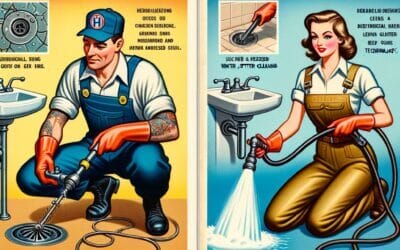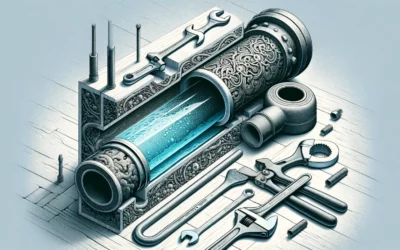Welcome to “Understanding and Preventing Home Toilet Clogs: Insights from Expert Plumbers”. This insightful post aims to provide you with professional knowledge and practical techniques to help you keep your home toilets running smoothly. Garnered from years of experience, our expert plumbers share their wisdom, providing you with the tools and understanding needed to prevent unwelcome toilet clogs. In addition to expert remedies, you will learn about the underlying causes and how to tackle them, potentially saving you considerable time and costs tied to frequent fixes. This easy-to-understand, information-packed post is sure to arm you with valuable knowledge, making toilet clogs a worry of the past. So, let us dive in to maintain the health of your home plumbing system. It’s time to plunge into the world of plumbing!
Understanding What Causes Toilet Clogs
Regular maintenance and appropriate usage can prevent most toilet clogs. However, there are several common causes of toilet clogs that every homeowner should be aware of. First, human waste and toilet paper are the only things intended to be flushed down a toilet. Flushing items such as wet wipes, diapers, paper towels, or feminine hygiene products, even if they are labeled “flushable,” can easily cause clogs. Toilet paper is specifically designed to break down in water, whereas other products are not.
Secondly, low flow toilets are more susceptible to clogs than older models due to the decreased amount of water used per flush. Occasionally, the amount of waste can exceed what the toilet is capable of handling, causing a clog. In older houses, it’s also common for the sewer pipes to have accumulations of calcified waste and even tree roots which can cause blockages. These issues can often be diagnosed and handled by a professional.
| Common Causes of Toilet Clogs |
|---|
| Flushing inappropriate items |
| Low flow toilets |
| Older houses with calcified waste or tree roots |
By understanding these causes, homeowners can take steps to prevent issues from arising. This includes educating everyone in the home about what can and can’t be flushed, and seeking professional assistance with older or low flow toilets to ensure they are functioning optimally. An ounce of prevention is worth a pound of cure, and proactive maintenance can save you from costly, inconvenient plumbing emergencies down the line.
In-depth Look at the Consequences of a Clogged Toilet
You might shrug off a clogged toilet as an unpleasant but non-critical inconvenience. However, frequent or severe toilet clogs could bear significant consequences for your home and finances. Unaddressed toilet clogs can lead to a range of problems, from pipes and septic system issues to home health hazards.
On the more straightforward side, consistent toilet clogs are often a symptom of broader plumbing issues. These might include obstructions in your sewer pipe or problems with your home septic system. Over time, these complications could escalate and require extensive, costly repairs. Unchecked clogs can also cause pipes to crack or burst, potentially causing significant water damage within your home.
- Sewer Pipe Problems: if left unattended, simple clogs can turn into significant obstructs in your sewer pipe, leading to a sewer backup in your home.
- Septic System Failure: when toilets are persistently clogged, it can lead to an overall strain on your septic system, leading to a complete system failure. This can cost thousands to replace.
In addition to these more mechanical consequences, clogged toilets can present health risks. Sitting water in a clogged toilet can breed bacteria and unpleasant odours. Worse still, a severe clog could result in a toilet overflow, spreading this bacterial to other areas of your home, increasing the risk of illness.
- Bacteria Breeding: the water in a clogged toilet can quickly become a breeding ground for bacteria, which may lead to foul odors and potential health hazards.
- Overflow Risks: A severe clog could cause the toilet to overflow, potentially spreading harmful bacteria throughout your home.
| Downside | Impact | Solution |
|---|---|---|
| Sewer Pipe Issues | Risk of sewer backup in your home | Regular inspections and proper maintenance |
| Septic System Failure | Could cost thousands to replace | Enlist a professional plumber for periodic clean-up |
| Bacteria Breeding | Potential health hazards | Address clogs immediately to prevent water stagnation |
| Overflow Risks | Elevated risk of spreading bacteria in home | Enlist professional help for serious clogs |
By understanding these potential consequences, you can take the necessary steps to prevent and promptly address toilet clogs. In the long run, this can save you money, preserve your home’s plumbing systems, and safeguard your family’s health.

Practical Steps to Prevent Toilet Clogs
If you’re constantly battling with clogged toilets around your home, it may be time to take active steps towards prevention. Clogged toilets are not only a nuisance but can directly lead to bathroom water damage if not handled correctly. But believe it or not, preventing toilet clogs is easier than you might think. With a few daily habits and regular maintenance, you’ll be on your way to a hassle-free toilet experience. Each time you flush, only organic waste and toilet paper should go down the drain. Try to avoid flushing items like wet wipes, diapers, paper towels, or feminine hygiene products even if they state to be flushable. Other materials are not designed to break down as quickly or thoroughly as toilet paper, and they have a higher likelihood of causing clogs. Regularly, talk to your family members, especially children, and remind them of the rule to keep your toilet clog-free.
Regular Maintenance Tips:
- Keep a small trash bin next to the toilet for non-flushable items
- Train household members to use only enough toilet paper necessary
- Schedule a regular professional inspection.
Furthermore, general maintenance is an often overlooked but essential aspect of preventing clogs. Routine professional inspections can help nip potential problems in the bud, but there are also at-home measures you can take. For instance, you should have a quality plunger accessible, and also, you may consider using a toilet snake for more significant blockages.
| Tools for Preventing Toilet Clogs |
|---|
| Quality Plunger |
| Toilet Snake |
| Radial Toilet Brush |
Remember, prevention is always better than cure. By implementing these measures, you will significantly reduce the occurrence of toilet clogs and help maintain the integrity of your home’s plumbing system. It’s a small price to pay for your peace of mind.
Valuable Tips and Hacks from Expert Plumbers
If you have ever experienced a toilet clog, you know it can be a frustrating and sometimes messy situation. Clogged toilets are common occurrences in most households, but they can be prevented with some careful tips and tricks from our expert plumbers. Proper maintenance and understanding the reasons why toilets get blocked will go a long way towards ensuring a smooth flowing toilet system.
Firstly, the type of bathroom tissue you use plays a critical role. Avoid using ultra plush or thick toilet paper as it takes longer to break down in the water, leading to potential clogs. Consider opting for a septic-safe or quick-dissolving variety instead. Next, it’s crucial to throw things in the trash, not the toilet. The toilet isn’t a trash can and shouldn’t be treated as such. Common household items like cotton swabs, dental floss, and even “flushable” wipes can cause significant blockages.
Being vigilant about the signals of a slow drain is also advisable. If you notice water levels rising higher than usual, or draining slower, it could be an early signal of a potential clog. Catching these signs early and responding quickly can prevent a full-blown clog and potential water damage.
| Tips and Hacks | Explanation |
|---|---|
| Use thinner toilet paper | Thicker toilet paper does not break down as swiftly and can cause blockages. |
| Avoid flushing household items | Items like cotton swabs, dental floss and wipes can create blockages despite being labelled as “flushable”. |
| Keep an eye on water levels | An unusual rise or slow drainage can be early signs of a potential clog. |
In conclusion, taking a proactive step in maintaining your toilet can save you time, money, and a potential headache. After all, prevention is better than cure. Remember these tips the next time you use your toilet, and hopefully, you will keep the plumber away.

Latest Plumbing Industry Insights to Keep Your Toilet Clog-Free
Dealing with a clogged toilet can be a real nightmare. As homeowners, we seldom give thought to the mechanics of our bathrooms until a clogged toilet gives us reason to. Most of the times, the causes of these clogs are quite preventable. As plumbing experts, we have some insights that can aid you in keeping a clog-free toilet. By knowing the common mistakes and incorporating preventive measures, you can avoid the hassle of dealing with a clogged toilet. The first step in prevention is understanding the common culprits behind a clogged toilet. The majority of toilet clogs are caused by things that are not supposed to be flushed. Make it a rule to dispose only toilet paper and human waste down the toilet. A common misconception is that “flushable” wipes are safe for your plumbing; while they may disappear down your drain, they could be causing significant blockages in your pipes.
Table 1. Common Causes of Toilet Clogs
| Causes | Solutions |
| Excessive use of toilet paper | Try to use only necessary amount |
| Flushing non-biodegradable items | Dispose of such items in a dustbin |
| Build-up of minerals in the pipes | Regular professional cleaning |
Next, keep your toilet pipes clean. Over time, hard water can cause minerals to build up in your pipes and cause blockages. Regular professional cleaning can prevent this accumulation and prolong the life of your pipes. Also, consider installing a water softener to reduce the chances of mineral build-up. Taking these preventive measures and educating household members on proper usage can go a long way in keeping your plumbing clog-free. After all, it is much easier to prevent clogs than it is to clear them.
From the Expert’s Desk: Solutions for Recurring Toilet Clogs
| Common Clogs Ingredients | Solutions |
|---|---|
| Thick Toilet Paper | Switch to a one-ply toilet paper |
| Foreign Objects | Avoid flushing anything other than toilet paper |
| Low Flush Toilet | Consider upgrading to a newer, more efficient model |
Future Outlook
In conclusion, understanding and preventing home toilet clogs is an essential skill that will save you both time and money. Expert plumbers concur that the key to this lies in acquiring the right knowledge, adhering to best practices, and using appropriate tools when necessary. By implementing the insights shared in this piece, you’ll lessen the chances of dealing with unsettling toilet clogs. Remember, the best course of action is always prevention. Fostering good habits, such as not flushing inappropriate items and performing regular maintenance checks, will significantly decrease the likelihood of encountering these pesky problems. If, however, you find yourself in a tricky situation that harsh chemicals and plungers can’t fix, don’t hesitate to call in the expert plumbers. Their scientific knowledge, hands-on experience, and professional judgment will always be a beneficial resource. It is our hope that this guide has given you a clearer understanding and useful tips on how to manage household toilet clogs. Stay smart, stay prepared, and keep your home problem-free.







